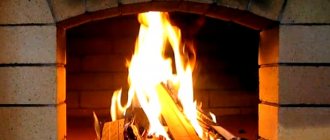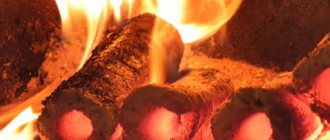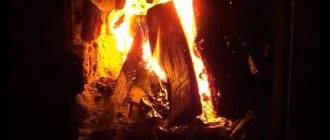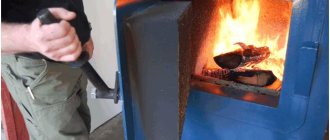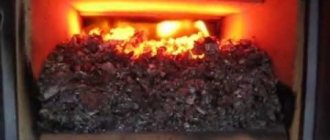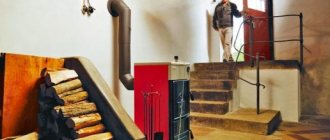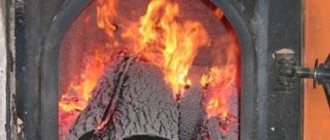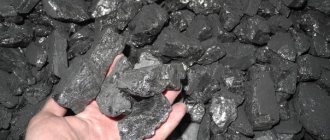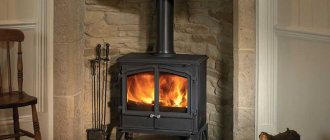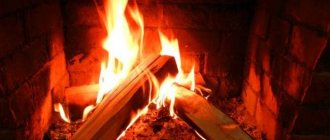Today, when we live in an age of high technology, it seems surprising that someone still uses wood for heating. If you look into any apartment or house, you can see modern heating appliances. However, do not forget about baths, saunas and fireplaces. For their work, “wood feeding” is necessary. Since people build them to pamper themselves, they want the quality to live up to their expectations. Although many people still use wood to heat their stoves and rooms, in recent years an alternative has emerged in the form of fuel briquettes.
What are fuel briquettes?
Fuel briquettes, which many also know as Eurowood , belong to the class of solid fuels that are produced by pressing sawdust and other natural materials under high pressure. It is possible to form wood waste into briquettes thanks to a special substance - lignin, which is present in any plant. Therefore, Euro firewood is completely safe, because in the process of its production no substances that can harm the environment or chemical reagents are used.
Types of Eurobriquettes
Companies involved in the sale of fuel can offer two types of fuel briquettes, which generally have the same characteristics.
Eurobriquettes RUF
They are made using the technology described above. The raw materials are sawdust and wood chips , which are compressed using a natural adhesive. The finished product has a rectangular shape. These fuel briquettes are the most popular because they are not only inexpensive, but also of good quality.
Eurobriquettes Pini-key
They are made according to a similar principle, however, there is one feature - at the very end of production they are fired . This allows the briquettes to be given natural protection from moisture, which significantly increases their shelf life.
This explains the higher cost of this firewood in contrast to the option described above. You can buy them for about 2 thousand rubles. for one ton. They also have external differences. In their shape they resemble a log with a through hole.
What is better to choose regular firewood or euro?
Fuel briquettes are no different from other products on the market, and they also have both advantages and disadvantages. If we compare briquettes with firewood, the former have the following positive aspects:
- Increased burning time compared to wood. They take 4 times longer to burn completely than regular firewood. Therefore, such briquettes are very economical.
- After combustion of fuel briquettes, a very small amount of ash is formed relative to the original weight - no more than 1%. Firewood is different in this regard - if you heat a stove with it, then after combustion it forms coal, which makes up about 20% of the initial volume of the material. Some owners use the ash obtained after burning Eurowood for their own benefit. This is an excellent fertilizer for the soil. As a result of its application to the site, seedling growth improves due to an increase in potassium content.
- Euro firewood provides more thermal energy - about 2 times.
- Modern fuel briquettes emit heat during almost the entire combustion process. In the case of conventional firewood, the heating power never remains constant and decreases over time. After about 15 minutes the coals are completely extinguished. Euro firewood emit the same amount of heat until it is completely converted into ash, and even when it has turned into coals, it burns for about 1 more hour. This fuel is ideal for those people who often go outdoors with a barbecue.
- If you heat the stove with briquettes, you will not get sparks, smoke or unpleasant odors. Therefore, the use of Euro-firewood does not harm the environment, as well as people who sit next to the heat source.
- The combustion process of Eurowood is not accompanied by the formation of substances hazardous to human health. This is explained by the presence of fungi and mold in ordinary firewood, which are not found in fuel briquettes. Microorganisms cannot withstand high temperatures and die, creating toxic smoke.
- When using Euro firewood, no soot is formed, so the chimney walls remain clean.
- Small sizes of Euro firewood. Thanks to this quality, they can be rationally placed in a small area, saving a lot of free space. They are offered to customers in the form of neatly stacked stacks. In contrast, firewood has different shapes and sizes, so it will not be possible to stack them neatly even if you want to. Everyone is familiar with the situation when firewood is delivered to the customer: it is simply dumped out of the truck onto any free space on the site. Then everything depends entirely on you - you will have to spend more than one hour to move them to the barn and put them in the order you need.
Even though fuel briquettes have a lot of advantages, the main one should be considered efficiency. Although for some buyers other useful qualities of European firewood will be of no small importance. This includes cleanliness and order . In the case of ordinary firewood, which many owners use to heat their stoves, a large amount of dust, chips and other debris is often formed. When using briquettes, the owner solves all these problems at once. However, is it only right to choose briquettes for this reason?
Conditions and course of the experiment
The object of inspection is a one-story private house with an area of 150 m² with an individual heating system from a solid fuel boiler. The walls are 300 mm thick and made of white sand-lime brick, with an air gap inside. There is no insulation of external fences; the windows are standard metal-plastic.
The remaining experimental conditions look like this:
- The heating system is closed, two-pipe. It is divided into 2 branches - radiators and heated floors. The initial water temperature is 43 °C.
- The average daily ambient temperature is 4–5 °C. The building is cold, warming up for the first time during the heating season.
- The heat source is a long-burning solid fuel steel boiler DIZ-24 (24 kW), equipped with a turbocharger and an automatic unit for maintaining the set temperature.
- The scheme uses a small capacity buffer tank (150 liters).
Note. Before the experiment, the boiler and coolant were heated to 43 °C by burning small logs.
Task: alternately load 3 types of fuel into the firebox and check the burning duration of each fill at a constant heating mode. The loading size is the same - 10 kg, the automation is set to maintain the water temperature at 50 °C.
Goal: to determine what will burn faster - firewood or briquettes, how significant the difference will be. The secondary goal is to compare the combustion process of three types of fuel:
- dry firewood from barn storage;
- round briquettes from sunflower husks;
- briquetted peat.
For reference. The type of wood used is small elm (otherwise known as birch bark), the stacking density of freshly cut logs with a moisture content of 50% is 600 kg/m³.
We deliberately did not burn “wood” briquettes made from sawdust. The reasons are obvious: the products are noticeably more expensive than peat and agricultural briquettes, and their combustion properties have been repeatedly tested. If you are interested in this type of solid fuel, we recommend watching the video:
The approximate density of pressed husks is 1800 kg/m³, peat briquettes are 2200 kg/m³. These data are for reference and do not play a big role in the experiment, since the fuel was supplied in the same amount - 10 kg. Let's start with burning wood.
The result of burning wood
During the inspection, the logs were cut into 4 logs and loaded into the firebox, where several hot coals remained. The controller started the fan and the firewood ignited within 1 minute. A total of 10 kg of wood was enough for 1.5 hours of boiler operation, after which the coolant temperature began to decrease.
The weight of each portion of fuel is 10 kg (with a bucket - 10.5 kg)
Points worth noting:
- dry firewood produces little smoke and burns very evenly;
- the temperature jump after turning off the fan does not exceed 3 degrees (up to 53 °C);
- small ash residue.
The process of burning dry wood is quite predictable. If you fill the entire chamber of a heat generator of this model (112 liters) with such fuel, 1 fill will be enough for at least 8 hours. Wet (freshly cut) firewood decays faster: it gives off less heat and is therefore more exposed to fan blowing.
A typical picture when burning dry wood is a slight smoke
Briquettes from sunflower husks
Since the pressed husk contains a proportion of vegetable oil, combustion differs in some ways:
- Immediately after placing 10 kg of cylindrical “sausages”, a sharp jump in temperature in the firebox is observed.
- While the oil vapors are burning, the pipe is actively smoking. At this stage, it is not recommended to open the loading door - a powerful flame from a sudden supply of oxygen can burn your face.
- After the boost is automatically turned off, the coolant temperature rises another 6-7 degrees (up to 57 °C), then decreases to normal.
- Until the bulk of the sunflower briquettes burn out, the fan is turned on only for blowing, which is enough to maintain the water temperature.
- When the oil vapors finally burn out, the amount of smoke from the chimney is noticeably reduced.
- The ash residue is insignificant.
At the initial stage (on the left) there is a lot of smoke, then it is practically invisible (on the right)
For reference. The purge mode lasts 10 seconds and turns on at intervals of 5 minutes. The goal is to free the boiler chamber from smoke.
The burning time of a portion of agricultural briquettes was 2 hours 10 minutes, which is 40 minutes longer than firewood. A caveat: you need to learn how to use fuel correctly - at the initial stage, the “sausages” emit a large amount of heat. By the way, in boilers with a mechanical draft regulator (without turbocharging), the effect of primary heating is less pronounced.
This is what the remains of a briquette look like at the after-burning stage, the boiler water temperature is 50 degrees
Combustion of pressed peat
In appearance, peat briquettes resemble coal briquettes, but differ in their square shape. The products also get dirty on your hands, so it is better to load them with gloves. Typical combustion moments look like this:
- under the influence of supercharging, peat ignites well and produces a stable, powerful flame;
- when the set coolant temperature reaches 50 °C, the fan stops, heating “jumps” to 53-54 °C;
- peat briquettes smoke more strongly than dry firewood;
- the amount of remaining ash is approximately 5-10%.
We couldn’t capture the smoke from the peat bricks in the photo because it was dark outside
Note. Peat contains a certain amount of loam, which turns into ash. The size of this share depends on the fuel manufacturer.
The operating time of a solid fuel boiler using peat briquettes is phenomenal - at least 3 hours, which is twice as long as burning the same amount of firewood. An unpleasant nuance is ash content and black dust that sticks to your hands.
Advantages of firewood compared to briquettes
- A major advantage of briquettes compared to firewood is their ability to generate stable heat over a longer period of time. Although the heat intensity is less than when using firewood. Therefore, if you want to quickly warm up the room with European wood firewood, as with ordinary wood, then you will not succeed.
- People who are used to spending the evening with a book or a cup of strong tea by the fireplace will most likely be disappointed. This fuel will not be able to please them with the crackling characteristic of ordinary firewood, which creates that unique feeling of home warmth and comfort. With the help of classic firewood, it is very easy to obtain the necessary “sound accompaniment”, since they contain water, but briquettes do not have it.
- When using Euro firewood, you will have to put up with the unpleasant smell of ash. Ordinary firewood will not give you such an unpleasant surprise, since wood ash does not emit a tart odor.
- Fuel briquettes, which are offered in stores today, are a rather fragile product that easily turn into crumbs. If you do not want to lose precious fuel before your eyes, then you should choose strong, high-quality briquettes.
Now it has become a little clearer about the advantages that firewood and fuel briquettes have. It remains to get an answer to one more question that worries many owners - which fuel is the most economical?
The question is the price
Fuel briquettes, like firewood, differ in their cost, which is determined by their quality. Today, companies offer two types of briquettes :
- Euro firewood of the highest quality, which is characterized by a high density of 1400 kg/m3. Among the advantages of these briquettes, it is worth noting a longer burning time, the ability to generate more heat and leave less ash. When finished, they are products of a dense structure without cracks.
- Euro firewood of ordinary quality, which has a density of 1000 kg/m3. Unlike briquettes of the highest quality, this Euro firewood has a layered structure and is more susceptible to damage. As they burn, they release less thermal energy, burn faster and produce more residue.
The uneven prices for fuel briquettes can be explained by the manufacturer's costs for equipment. If you press briquettes , you can get a better final product, but at the same time it accelerates equipment wear. All this is taken into account by manufacturers and included in the final price of the product.
It is quite logical that high quality European firewood will cost more than regular briquettes. But at the same time, briquettes of the highest quality will be more economical for the buyer compared to ordinary birch firewood. What can we say about briquettes of ordinary quality.
Even if someone thinks that the cost of such fuel is too high compared to firewood, you can always find a way to save money - make it yourself. First, you will have to stock up on raw materials for fuel briquettes - twigs and twigs, which you will probably find on your site. You need to add a little clay to them and fill them with water . You need to add water little by little so that the mixture can be formed into bars.
Next, you will need molds - without them you will not be able to make briquette fuel correctly. They need to be filled with the prepared mixture, placed under a press and allowed to lie in the sun for a couple of days. But don’t expect homemade stove briquettes to be of the same quality as store-bought briquettes. However, you can save money this way. Another positive aspect of this solution is that you will be able to clear your area of debris.
The cheaper way to heat your home
The price of fuel for heating a private home is of great importance, but it is pointless to consider it in isolation from heat transfer. We will calculate the cost of heating taking into account both parameters.
Combustion of peat fuel 3 hours after laying
In the area where our expert lives, the following prices are asked for proven types of fuel:
- Freshly cut firewood – 20 USD. e. for 1 m³. Let's tie the price to the weight: 20 dollars for 600 kg or 33 cu. e. for 1 ton.
- Briquettes made from pressed sunflower husks – $57 per ton.
- Peat briquette – 84 USD. e./1 t.
It is easy to calculate that 10 kg of wood will cost 33 cents, the rest of the fuel - 57 and 84 cents, respectively. Then 1 hour of heating on wooden logs costs 33 / 1.5 = 22 cents (remember, the wood burned out in an hour and a half).
In a similar way, we determine the hourly rate for burning briquettes:
- pressed husk: 57 / 2.17 (2 hours 10 minutes) = 26 cents;
- briquetted peat: 84 / 3 = 28 cents.
Burning briquetted sunflower seed husks.
Interesting result, right? In our case, heating up an absolutely cold building costs 5.28 USD. e. per day for wood, 6.24 dollars for pressed husks and 6.72 cu. e. - on peat “bricks”.
An important nuance. The prices of solid fuel in your region are probably different, and the boiler room has different heating equipment. But the ratio and principle of calculation remain unchanged. Apply this technique and consider what is more profitable - firewood or briquettes in your particular case.
Please note that we took the cost of raw wood (and it will decay sooner) and divided it by the time of full combustion of dry wood. That is, the difference between traditional fuel and briquettes is minimized. We suggest watching the progress of the experiment on video and listening to an expert’s opinion on this matter:
So which is better?
Considering the above, we can highlight the main advantages that fuel briquettes have - high burning time, saving storage space, lack of garbage, safety for the environment and a more affordable price compared to conventional firewood. But if you are not ready to deprive yourself of the opportunity to enjoy the crackle of burning dry birch logs, then you will not experience much benefit from buying Euro firewood. In addition, briquette fuel will not help you warm up the room as quickly as firewood.
It follows that when choosing fuel, you must first take into account both the characteristics and positive aspects of each product, as well as the purposes for which you intend to use them.
The secret of the popularity of compressed fuel
If we summarize all the positive qualities of various types of briquettes, we can say that their use is much more rational and productive than heating rooms with traditional fuel - coal or wood. The only negative that keeps many from purchasing is the higher cost, but the unique set of useful qualities fully justifies it:
- safety - the amount of harmful smoke is minimal, the occurrence of sparks is practically excluded;
- high heat transfer, respectively, increased heat volume;
- low humidity, which affects combustion efficiency;
- combustion quality - the process proceeds long and evenly;
- compactness, convenient for storage and transportation;
- possibility of long-term storage and purchase “in reserve” - compressed fuel is sold in sealed packages.
Neatly decorated, clean briquettes near the fireplace or stove are a kind of sign of a comfortable life. They do not stain your hands and floors like coal, and do not leave debris like firewood. The absence of smoke and large amounts of ash completes the picture of well-being.


